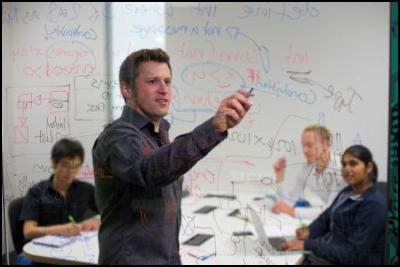New programming language could create a safer world

MEDIA RELEASE
9
January
2013
____________________________________________________
New programming language could create a safer world
Research underway at Victoria University into a new programming language has the potential to prevent future software failures in safety-critical systems.
Infamous examples of software failures include the Therac-25 disaster, where a computer-operated radiation therapy machine gave patients lethal doses; and an enormous power outage in the United States in 2003, which led to around 45 million people being without electricity for up to two days.
In New Zealand, software glitches have caused a bank to mistakenly gift its customers unlimited overdraft access (TSB, 2012); a security system to open what should have been a closed supermarket (Mill St Pak ‘n Save in Hamilton, 2011); and broadband meters to incorrectly calculate usage (Telecom, 2011).
Dr David Pearce, from Victoria’s School
of Engineering and Computer Science, has designed a
programming language that uses automated mathematical and
logical reasoning to check computer software decisions are
correct.
“Currently, the most widely accepted way of
eliminating software errors is through extensive testing.
But as systems become increasingly complex this cannot
always guarantee the absence of errors, because in large
systems it simply isn’t feasible to test every possible
input,” he says.
“Software is becoming more and more ubiquitous—it’s involved in all sorts of things we do in the modern world. As software engineers we need to find ways of making sure we eliminate as many errors as we possibly can.”
Dr Pearce has been developing the programming language, Whiley, since 2009 and in 2011 received a Marsden Fast-Start grant to further its progression.
Dr Pearce sees Whiley having applications for everyday software programs, as well as highly-specialised software for systems where people’s safety is paramount, such as modern cars, which now typically run on close to 100 million lines of computer code.
“Certain mistakes are common in computer programs, for example overflow errors, where a number is simply too large for the computer to handle,” he says.
“Whiley has the potential to ensure that scenarios like this can be avoided in the future, by testing the logic of the program in advance.”
ENDS


 National Youth Theatre: 140 Christchurch Kids Shine In National Youth Theatre’s Historic CATS Premiere
National Youth Theatre: 140 Christchurch Kids Shine In National Youth Theatre’s Historic CATS Premiere NZ Symphony Orchestra: NZSO To Tour Masterworks By Mozart, Beethoven, Haydn And More
NZ Symphony Orchestra: NZSO To Tour Masterworks By Mozart, Beethoven, Haydn And More Journal Of Public Health: Vape Shops Cluster Around Schools
Journal Of Public Health: Vape Shops Cluster Around Schools Timaru District Council: Aigantighe Art Gallery Hosts An Iconic Robin White Touring Exhibition
Timaru District Council: Aigantighe Art Gallery Hosts An Iconic Robin White Touring Exhibition Victoria University of Wellington: Dame Winnie Laban Awarded Honorary Doctorate Recognising Achievements For Pasifika
Victoria University of Wellington: Dame Winnie Laban Awarded Honorary Doctorate Recognising Achievements For Pasifika  HESSA: This Isn’t Fair—And It’s Time To Fix It - HESSA Petition Calls For Inclusive Student Sports
HESSA: This Isn’t Fair—And It’s Time To Fix It - HESSA Petition Calls For Inclusive Student Sports